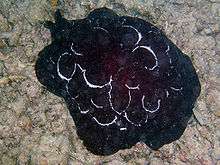Pleurobranchidae
| Pleurobranchidae | |
|---|---|
 | |
| Pleurobranchus forskalii | |
| Scientific classification | |
| Kingdom: | Animalia |
| Phylum: | Mollusca |
| Class: | Gastropoda |
| (unranked): | clade Heterobranchia clade Euthyneura |
| Superfamily: | Pleurobranchoidea Gray, 1827 |
| Family: | Pleurobranchidae Gray, 1827 [1] |
| Type genus | |
| Pleurobranchus Cuvier, 1804 | |
| Subfamilies | |
| |
| Synonyms[2] | |
| |
The Pleurobranchidae are a taxonomic family of sea slugs, marine gastropod molluscs in the clade Pleurobranchomorpha. Species in the family Pleurobranchidae have a prominent mantle and an internal shell that becomes reduced or is lost completely in adults.[3] Some adult species have been seen feeding on ascidians. Larval pleurobranchids can be planktotrophic (feeding on plankton), lecithotrophic (deriving nutrition from yolk), or direct developing.
Many species produce secretions from their rich glandular mantle as a chemical defense against predators.[4] Even the production of sulfuric acid has been reported.[5]
Taxonomy
Until 2005, this family was placed in the suborder Notaspidea. However, in the taxonomy of Bouchet & Rocroi (2005), the family Pleurobranchidae was placed in the superfamily Pleurobranchoidea, the only family belonging to the subclade Pleurobranchomorpha (sister to the subclade Nudibranchia), part of the clade Nudipleura.
Subfamily Pleurobranchinae
- Bathyberthella
- Bathyberthella antarctica Willan and Bertsch, 1987 [6]
- Berthella de Blainville, 1824
- Berthella africana Pruvot-Fol, 1953 [7]
- Berthella agassizi MacFarland, 1909
- Berthella americana A. E. Verrill, 1885
- Berthella aurantiaca Risso, 1818
- Berthella caledonica Dall, 1900
- Berthella californica Dall, 1900 California sidegill slug
- Berthella canariensis Cervera, J.L., T.M. Gosliner, J.C. García-Gómez & J. Ortea, 2000
- Berthella elongata Cantraine, 1835
- Berthella martensi Pilsbry, 1896
- Berthella medietas R. Burn, 1962
- Berthella ocellata delle Chiaje, 1830
- Berthella ornata T.F. Cheeseman, 1878
- Berthella patagonica d'Orbigny, 1837
- Berthella platei Bergh, 1898 [8]
- Berthella plumula Montagu, 1803
- Berthella sideralis Lovén, 1846
- Berthella stellata Risso, 1826
- Berthella strongi MacFarland, 1966
- Berthella tamiu Ev. Marcus, 1984 [9]
- Berthella tupala Er. Marcus, 1957
- Berthellina Gardiner, 1936
- Berthellina amarillus Mattox, 1953
- Berthellina americanus Verrill, 1885
- Berthellina circularis Mörch, 1863
- Berthellina citrina Rüppell & Leuckart, 1828 (synonym of Gymnotoplax citrina Er. Marcus, 1957 )
- Berthellina delicata W.H. Pease, 1861
- Berthellina edwardsi Vayssière, 1897
- Berthellina engeli Gardiner, 1936
- Berthellina granulata (Krauss, 1848)
- Berthellina ilisima Marcus, Er. & Ev. Marcus, 1967
- Berthellina quadridens Mörch, 1863 (junior synonym of Gymnotoplax quadridens)[10]
- Boreoberthella Martynov & Schrödl, 2009
- Bouvieria Vayssière, 1896 : synonym of Berthella Blainville, 1824
- Gigantonotum: synonym of Berthella Blainville, 1824
- Gigantonotum album Lin, G. & S. Tchang, 1965
- Gymnotoplax Pilsbry, 1896 : synonym of Berthella Blainville, 1824
- Gymnotoplax citrina Er. Marcus, 1957
- Gymnotoplax engeli Gardiner, 1936
- Gymnotoplax quadridens
- Oscanius Leach, 1847 : synonym of Pleurobranchus Cuvier, 1804
- Oscanius tuberculatus Meckel, 1808
- Parabathyberthella: synonym of Bathyberthella Willan, 1983
- Parabathyberthella eltanini Dell, 1990
- Parabathyberthella orcadensis Talavera, F.G., J.C. García-Gómez, J.S. Troncoso & J.L. Cervera, 1994
- Pleurehdera Ev. Marcus & Er. Marcus, 1970
- Pleurehdera haraldi Ev. Marcus & Er. Marcus, 1970
- Pleurobranchus Cuvier, 1805
- Polictenidia: synonym of Bathyberthella Willan, 1983
- Polictenidia tomasi Talavera, F.G., J.S. Troncoso, J.L. Cervera & J.C. García-Gómez, 1996
- Susania: synonym of Pleurobranchus Cuvier, 1804
- Susania testudinaria Cantraine, F.J., 1840 (synonym of Pleurobranchus testudinarius)
- Tomthompsonia
- Tomthompsonia antarctica Thiele, 1912
Subfamily Pleurobranchaeinae
Raised to the rank of family Pleurobranchaeidae Pilsbry, 1896
References
- ↑ Encyclopaedia metropolitana, Volume 7, Plates to Zoology; plate Mollusca III (plate 4)
- ↑ Bouchet, P. (2011). Pleurobranchidae. Accessed through: World Register of Marine Species on 2011-06-30
- ↑ R. Willan (1987). "Phylogenetic systematics of the Notaspidea (Opisthobranchia) with a reappraisal of families and genera". Am. Malacol. Bull. 5: 215–241.
- ↑ Aldo Spinella; Ernesto Mollo; Enrico Trivellone; Guido Cimino (December 1997). "Testudinariol A and B, two unusual triterpenoids from the skin and the mucus of the marine mollusc Pleurobranchus testudinarius". Tetrahedron. 53 (49): 16891–16896. doi:10.1016/S0040-4020(97)10124-7.
- ↑ T. Thompson (1988). "Acidic allomones in marine organisms". J. Mar. Biol. Assoc. UK. 68 (3): 499–517. doi:10.1017/S0025315400043368.
- ↑ Francisco José García; José Carlos García-Gómez; Jesús S. Troncoso; Juan Lucas Cervera (May 1994). "A descriptive study of some Antarctic notaspidean opisthobranchs (Gastropoda), with description of a new genus and species". Polar Biology. 14 (4): 261–268. doi:10.1007/bf00239174.
- ↑ Cervera et al. (2000). A new species of Berthella Blainville, 1824 (Opisthobranchia: Notaspidea) from the Canary Islands (Eastern Atlantic Ocean), with a re-examination of the phylogenetic relationships of the Notaspidea. J.Moll. Stud., 66: 3001-311.
- ↑ Michael Schrödl (1999). "The genus Berthella Blainville, 1825 (Notaspidea, : Pleurobranchidae) from Magellanic waters". Journal of Molluscan Studies. 65 (4): 399–409. doi:10.1093/mollus/65.4.399.
- ↑ Marcus, Ev. 1984. The Western Atlantic warm water Notaspidea (Gastropoda, Opisthobranchia), Parte 2 Boletim de Zoologia, Universidade de Sao Paulo 8 p. 43-76.
- ↑ Mörch, 1863. Contributions à la faune malacologique des Antilles danoises Journal de Conchyliologie 11 21-43.
External links
- "Scientists just collected a mysterious 'purple orb' at the bottom of the ocean, but no one could anticipate what happened next" (Video). Business Insider. July 30, 2016. Retrieved July 30, 2016.
- Richard C. Willan, Description of a New Pleurobranch (Opisthobranchia, Notaspidea) from Antarctic with a review of Notaspideans from South Polar Seas; The Veliger 29 (3), 1987 p. 292-302
| Wikimedia Commons has media related to Pleurobranchidae. |
